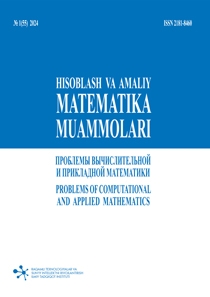NUMERICAL MODELING OF TURBULENT FLOWANDAIR POLLUTANT DISPERSION IN URBAN STREET CANYONS
Keywords:
mass transfer in the atmosphere, vehicle emissions, urban development, Navier–Stokes equations, numerical algorithm, Crank–Nicholson scheme, Jacobi methodAbstract
Large cities often face challenges in providing an eco-friendly living space. This is crucial in residential areas where the majority resides, aiming for high social and envi ronmental comfort. Key pollution sources include industrial sites, utilities, and notably, road traffic, which is a major contributor. City overpasses can significantly exacerbate pollution levels. Computational fluid dynamics offers effective tools for analyzing and pre dicting pollutant dispersion, considering air flow dynamics and urban structures. This study focuses on modeling pollutant spread in turbulent flows within street canyons, employing the Navier–Stokes equations, Poisson’s equation for pressure, and advection diffusion equations, solved using a Crank-Nicholson scheme. The findings are presented graphically, with interpretations provided.
References
Равшанов Н., Мурадов Ф., Ахмедов Д. Численное моделирование процесса переноса и диффузии вредных веществ в атмосфере в сферической системе координат // Проблемы оптимизации сложных систем : материалы XIV международной азиатской школы-семинара, 20-31 июля 2018 г., Кыргызстан : в 2-х ч. Ч. 2..– Алмата, 2018.– С. 142-151. (Ravshanov N., Muradov F., Akhmedov D. Chislennoye modelirovaniye protsessa perenosa i diffuzii vrednykh veshchestv v atmosfere v sfericheskoy sisteme koordinat // Problemy optimizatsii slozhnykh sistem : materialy XIV mezhdunarodnoy aziatskoy shkoly-seminara, 20-31 iyulya 2018 g., Kyrgyzstan : v 2-kh ch. CH. 2..– Almata, 2018.– S. 142-151.)
Равшанов Н., Шарипов Д.К., Ахмедов Д. Моделирование процесса загрязнения окружающей среды с учетом рельефа местности и погодно-климатических факторов // Информационные технологии моделирования и управления.– 2015.– №3(93).– С. 222 234. (Ravshanov N., Sharipov D.K., Akhmedov D. Modelirovaniye protsessa zagryazneniya okruzhayushchey sredy s uchetom rel'yefa mestnosti i pogodno-klimaticheskikh faktorov // Informatsionnyye tekhnologii modelirovaniya i upravleniya.– 2015.– №3(93).– S. 222 234.)
Шарипов Д.К., Ахмедов Д.Д. Моделирование процесса переноса вредных веществ в атмосферу с учётом эрозии почвы // Проблемы информатики и энергетики.– 2015. №5.– С. 23-32. (Sharipov D.K., Akhmedov D.D. Modelirovaniye protsessa perenosa vrednykh veshchestv v atmosferu s uchotom erozii pochvy // Problemy informatiki i energetiki.– 2015. №5.– S. 23-32).
Haeckel E. Generelle Morphologie der Organismen. Bd.2.– Berlin: Georg Reimer, 1866. 652 p.
Наместникова О.В., Топольский Н.Г. Обзор моделей загрязнения атмосферного воз духа в системе управления качеством среды обитания // Пожары и чрезвычайные ситуации: предотвращение, ликвидация.– 2015.– №2.– С. 64-70. (Namestnikova O.V., Topol'skiy N.G. Obzor modeley zagryazneniya atmosfernogo voz dukha v sisteme upravleniya kachestvom sredy obitaniya // Pozhary i chrezvychaynyye situatsii: predotvrashcheniye, likvidatsiya.– 2015.– №2.– S. 64-70).
Collett R., Oduyemi K. Air quality modelling: a technical review of mathematical approaches // Meteorological Applications.– 1997.– Vol. 4.– P. 235-246.
Pantusheva M., Mitkov R., Hristov P., Petrova-Antonova D. Air Pollution Dispersion Modelling in Urban Environment Using CFD: A Systematic Review // Atmosphere. 2022.– Vol. 13.– P. 1-35.– doi: http://dx.doi.org/10.3390/atmos13101640.
Markiewicz M. A Review of Mathematical Models for the Atmospheric Dispersion of Heavy Gases. Part I. A Classification of Models // Ecological Chemistry and Engineering.– 2012. Vol. 19.– P. 297-314.
Baklanov A. Application of CFD methods for modelling in air pollution problems: possibilities and gaps // Environmental Monitoring and Assessment.– 2000.– Vol. 65. P. 181-189.
Kalita P., Ukaszewicz G. NameNavier-Stokes Equations : an Introduction with Applications.– Cham: Springer, 2016.– 390 p.
Polyanin A., Nazaikinskii V. Handbook of Linear Partial Differential Equations for Engineers and Scientists.– 2nd ed.– New York: Chapman and Hall/CRC, 2016.– 1643 p.
Stocker T. Introduction to Climate Modelling.– Heidelberg: Springer, 2011.– 182 p.
Sharipov D., Muradov F., Akhmedov D. Numerical Modeling Method for Short-Term Air Quality Forecast in Industrial Regions // Applied Mathematics E-Notes.– 2019.– No. 19. P. 575-584.
Thomas J.W. Numerical Partial Differential Equations: Finite Difference Methods.– New York, Springer, 1995.– 437 p.
Ravshanov N., Akhmedov D.D., Roziyeva G. GIS based estimation of the vertical wind profile effect on air pollutants disperse in the atmosphere // AIP Conference Proceedings. 2023.– Vol. 2781.– doi: http://dx.doi.org/10.1063/5.0144801.
Sharipov D., Akhmedov D., Boborakhimov B., Sharipov Kh. Modelling of Fine Aerosols Diffusive Transport in the Atmosphere // Int. Conf. on Inform. Sci. and Comm. Tech. (ICISCT).– 2022.– P. 1-6.– doi: http://dx.doi.org/10.1109/ICISCT55600.2022. 10146840.
Sharipov D., Akhmedov D. Aggregation of Meteorological and Spatial Data for Air Pollution Modeling // Int. Conf. on Inform. Sci. and Comm. Tech. (ICISCT).– 2021.– P. 1-4. doi: http://dx.doi.org/10.1109/ICISCT52966.2021.9670325.
Ravshanov N., Akhmedov D., Kravets O.Ja. Atmospheric dispersion modeling in ecological engineering problems // IOP Conf. Series: Materials Science and Engineering.– 2020. Vol. 862.– P. 1-8.– doi: http://dx.doi.org/10.1088/1757-899X/862/6/062017.

Downloads
Published
Issue
Section
License
Copyright (c) 2024 N. Ravshanov

This work is licensed under a Creative Commons Attribution 4.0 International License.